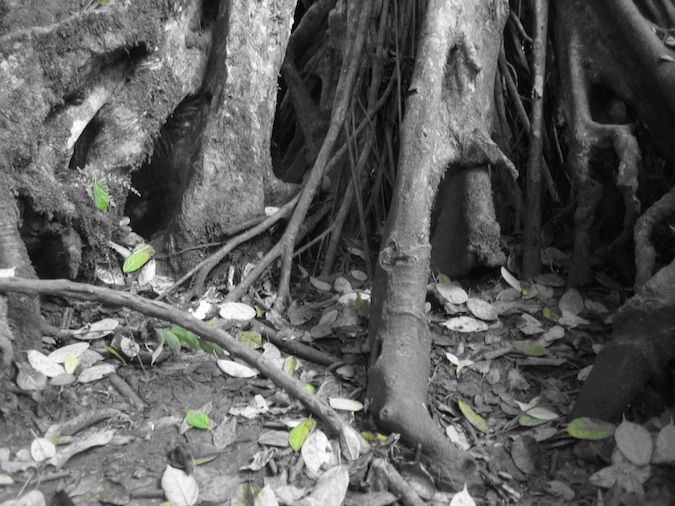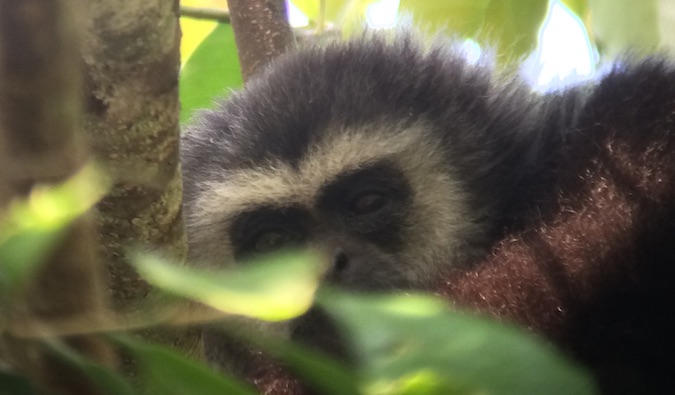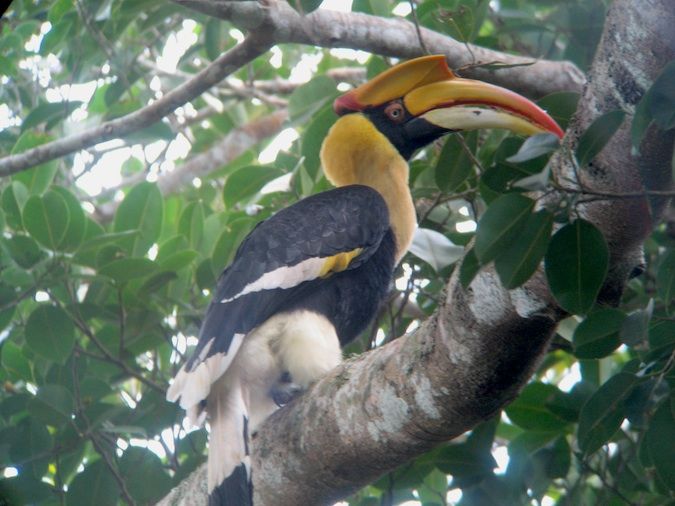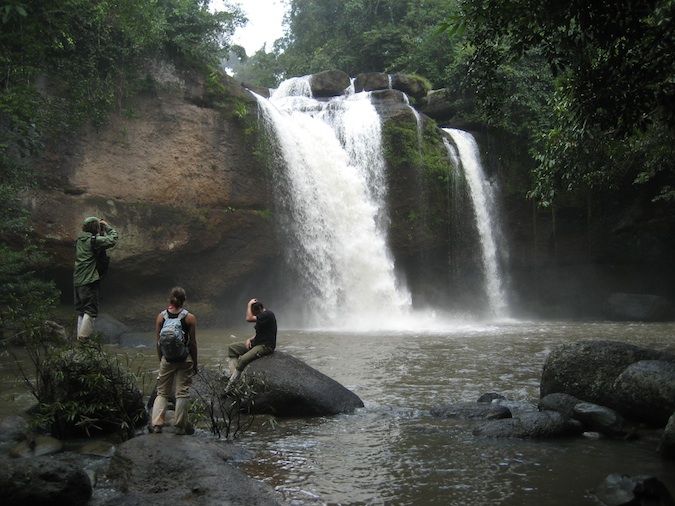How to Visit Khao Yai National Park

Khao Yai National Park is located about 2.5 hours north of Bangkok
and is one of Thailand’s best national parks. Established in 1962, it
was Thailand’s first national park and is now even a UNESCO World
Heritage site.
I’d always heard great things about the park while I lived in the country.
Despite living in Thailand for several years, I never managed to get
there. But, luckily a got to play tour guide to a friend from Boston on a recent visit and used that as my excuse to finally make it there.
I can’t believe it took me so long.
The
park is truly amazing. It’s filled with lush flora and fauna, tons of
birds, waterfalls, beautiful hikes, a few wild elephants, and is empty
of tourists.
Arriving at our guesthouse in the afternoon, we were
just in time to make a half-day tour. This tour brought you to a few
caves and a natural spring. The first cave was home to over 2,000 bats
and used to be a Buddhist monastery before the local community helped to
build the monks a proper temple. However, the monks still come down
here at night to meditate. I suspect the darkness and tranquility are
good for meditation.

Our
guide seemed to be an expert in everything, showing us all the insects,
talking about the life cycle of bats, and even giving us a soil lesson
on the composition of the dirt and how bat guano can be used to make
explosives. Usually, when you’re visiting Thailand,
tour guides are just ushers, walking you from place to place,
discussing very little, letting you take your photos, and then moving
on. But this guide knew it all and was able to explain the history and
zoology of not only this cave but the whole region.

The
second cave featured over two million bats, and we arrived just in time
to see them head out for their nightly feed. Watching it was like
watching something on the Discovery Channel, a seemingly endless stream
of bats flying out in pursuit of their evening meal as the sun set below
the horizon. Our guide, who seemed to know our cameras better than any
of us, was able to catch some of it on tape for us through the
telescope:
We
spent the following day back in the park for a full day of hiking
through the jungle and trying to spot wildlife. Our day began with bird
watching, followed by a five-hour trek through the jungle.
We spotted a lot of birds throughout the day, including the Great
Hornbill, which has a wingspan over two meters wide. Monkeys hovered on
the side of the road, and gibbons swung through the trees. As we made
our way through the jungle, it became clear to me we were the only group
on this trail, allowing us extra personal time with the animals.
Usually, in northern Thailand, you see a lot of tour groups on the
trails, so it was nice to finally get somewhere where we could be alone
with nature.

The
monsoon season kicked in about halfway through our trek, pouring down
an ocean of water on us as we made our way back to the car. The rain
abated just as we hit the last few waterfalls, including the one
Leonardo Di Caprio jumped off in the movie The Beach.
Now, normally I never use Lonely Planet
for accommodation recommendations. However, this time, I did (as did
everyone else at the guest house). I must say that for once, Lonely
Planet didn’t disappoint. Despite being in LP for years, the Greenleaf
Guesthouse had not suffered in quality (and having been back since, I
can say it’s still one of the best places to stay). Usually, press in a
Lonely Planet book means higher prices and poorer quality. However, this
place offered cheap accommodation, excellent food, reasonably priced
tours, and very knowledgeable tour guides. If you ever go to Khao Yai,
this place comes with my highest recommendation. I’d go back in a
second.

Despite
being one of the biggest and most well-known parks in Thailand, there
were few tourists there, making for an enjoyable and peaceful
experience. With it being only half a day from Bangkok, you should
really consider visiting Khao Yai before you head off to the tropical islands that make Thailand so famous.
Things to See in Khao Yai National Park
Here are some of the best things to see during your visit to the park:
- Haew Suwat Waterfall – This waterfall was made famous in The Beach and is definitely worth seeing (though unfortunately, you won’t be able to mimic Leo’s classic jump!).
- Pha Diew Die viewpoint – At 1,100m above sea level, this is probably the most breathtaking viewpoint in the park. You’ll get a sweeping view of the whole area and there are usually very few people around.
- Haew Narok Waterfall– This waterfall translates to “Sunken Hole of Hell” which is a very foreboding name for a gorgeous waterfall! It got its names from poachers who apparently heard the noise of its water crashing long before they saw the water and assumed it the crashing rumble was the gates of hell opening.
- Non Pak Chi Watchtower – This is a good place to stop to try and see some of the park’s wildlife, such as wild boars and elephants. Aim to be here for dawn or dusk for the best chances.
- See elephants (and other wild animals) – Best found at sunrise or sunset, there are actually over 400 elephants located in the park. You can find them near some of the salt licks around the park, though you have to be patient (and lucky!). The best way to see them (and other animals) is to go on a night safari, as many animals prefer to be active during the cool night hours. Tours are organized by the park and cost 200 THB per vehicle (which usually has room for up to 8 people).
How to Get to Khao Yai National Park
If
you want to visit the park, you’ll need to head to Pak Chong — it’s the
closest town. Buses leave frequently from Bangkok’s Mo Chit Bus Station
and the journey takes 3-4 hours. Expect to pay around 150-200 THB for
the bus. You can also take the train from Bangkok but the journey is
much slower. Expect to pay at least 400 THB or the train (though it is
rather scenic). All guesthouses will pick you up from the bus or train
station if you let them know when you’re arriving. They can also arrange
a tour of the park (full day, half day, or multi-day). Prices begin at
500 THB per person for a half-day tour. Admission to the park itself is
400 THB for international visitors.
You can hike many of the
shorter trails yourself as well as camp in the park too. Regular
Songthaew service runs from Pak Chong to the park entrance, though from
there it is still 10km to get into the park. The ride from Pak Chong
takes around 40 minutes and costs 40 THB. There are limited spots so
book in advice. I wouldn’t hike one of the longer trails without a
guide.
Another great way to explore the park is by motorcycle. You
can rent motorcycles nearby for 300 THB per day, which includes 2
helmets. You can buy fuel in the park at the guard station for around 40
THB per bottle. Car rentals are also available for closer to 2,000 THB
per day. Conversely, if you want to visit yourself but would rather not
drive, you can hitchhike around the park. It’s very easy and people are
usually happy to shuttle you around.



No comments